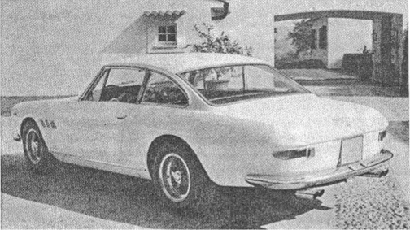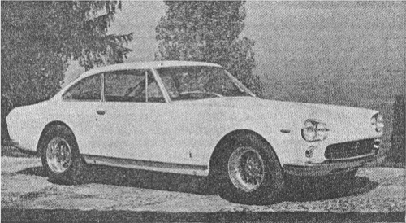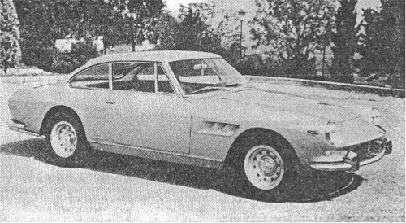 | 330 GT Registry |  |
Volume 12 Number 8
18 April 1987
FERRARI 330 GT 2+2
The 330 GT 2+2 is the Rodney Dangerfield of the V-12 Ferraris, a Ferrari that gets no respect. Let me quote from the great works of Ferrari literature. Fitzgerald and Merritt wrote that it was “rather dull by earlier Ferrari standards and its frontal appearance was marred by the adoption of a four-headlamp system. . . . [It] cannot be said to have been a beauty.” Dean Batchelor’s Illustrated Ferrari Buyer’s Guide comments that with the 330 GT 2+2 “the Ferrari prancing stallion became a Percheron”. In The Ferrari Legend: The Road Cars Antoine Prunet wrote that the 330 GT 2+2’s styling was “more bare . . . . The bulbous rear was also somewhat bulky”, and the four headlights were “a concession to the fashions of the day and were met with mixed reviews.” Finally, Godfrey Eaton echoed this sentiment in The Complete Ferrari: The four headlight arrangement “was a feature that met with some what mixed reviews and, together with a somewhat bulbous rear, took away the sharpness of line that was so attractive on the 3-litre cars..”
It also gets no respect in the market. While it is true that in my last analysis of 12 cylinder Ferrari prices (Volume 12, Number 1) both the 250 GT Pininfarina Coupe and 250 GTE 2+2 had lower average as prices than the 330 GT 2+2, the figures for the 330 were compiled using both four and two headlight versions. When just four headlight examples on the market were tabulated, the average asking price was $17,875, the lowest figure for any V-l2 Ferrari. Even when it comes to eliminating a Ferrari--either through parting out or building a fake, bogus, replica, or counterfeit--the early 330 GT 2+2’s get no respect. A great many 250GT parts are interchangeable amongst the various models; and with the similarities between the 250’s building a plausible replica is simple. But many early 330 GT 2+2 parts are interchangeable only with other early 330 GT 2+2’s; and no competition or sporty Ferrari types were similar enough for easy cloning.
The styling of the rear of the 330 GT 2+2, although not always admired, was not the most often criticized feature of the design. The new shape by Pininfarina increased rear seat headroom and trunk space. |  |
But the type deserves a better reputation. It is one of my personal pet beliefs that Enzo Ferrari did not force all those people to purchase 330 GT 2+2’s during the days from late 1963 through 1967 that the type was in production. How many bought new 330 GT 2+2’s? Production was approximately 1,085 units, or about one-half of all the Ferraris made during that span. Keep in mind that these buyers did not succumb to the charms of’ the 250 GT Berlinetta Lusso, the 275 GTB, or the 275 GTB/4; nor did they answer the siren call of the 275 GTS, the 330 GTS, the N.A.R.T. Spyder, or the 365 California. Instead they purchased a Ferrari for touring in the grand manner, the type of automobile that another manufacturer used to advertise as “space, pace, grace.”
Although production of the 330 GT 2+2 had quietly begun in late 1963, it made its official debut at the Ferrari Press Conference in January of 1964. It was, in many ways, an all new car. While the chassis followed traditional Ferrari construction, the wheelbase was increased from 2600 to 2650 mm over the 250 GTE 2+2, giving more room inside, and the styling also increased headroom and trunk space. The engine was a new unit (Ferrari Type 209), with the basic Colombo construction of the 250 and the bore and stroke dimensions of the 400 SA in a new longer block. There were also improvements made in the transmission, overdrive unit, suspension, and brakes. The result was an improved vehicle with enhanced performance. A survey of contemporary road tests gives the top speed of 148 mph; 0-60 mph time of 6.8 seconds; and 0-100 mph time of 16.6 seconds--an impressive set of figures then and not too shabby even now.
As for the grace part, well, even Pininfarina recognized the folly of following a fad and in late 1965 a new front end was introduced, with the more traditional two headlights. It may have still lacked the aggressiveness of its stablemates at Ferrari, but when analyzed on its own merits rather than compared with Ferraris intended for other purposes, the 330 GT 2+2 doesn’t come off all that poorly.
Ferrari also improved the type mechanically. In early 1965 the four-speed plus over drive transmission was scrapped in favor of a true five-speed. At this time a new clutch (by Borg & Beck) and pedal system was adopted. In 1966, after the 330 GTC was introduced, the 2+2 received the new two-mount engine, reducing the noise and vibration transmitted to the interior. Also, for even grander touring, air conditioning and power steering became available as options.
So, in essence, there were three basic 330 GT 2+2 models made by Ferrari. First the four headlight four-speed plus overdrive version of which 500 (50 R.H.D.) were made in the serial number range from 4963 through 6937. Then came the four headlight five-speed version of which 125 (9 R.H.D.) were made from serial number 6939 through 7547. Finally the two headlight five-speed version of which 460 (36+? R.H.D.) were made in the serial number range from 7553 through 10193. This gives a total of 1,085 330 GT 2+2’s built.
But as is true with virtually all Ferraris, such neat categorizing does not tell the whole story. A study of the Pininfarina Body Parts Catalog reveals some 27 changes in details, starting as early as the 65th body and lasting as late as the 1011th body. Add to this the mechanical changes introduced by Ferrari, the standard options available, and the special features that a customer with enough money and/or influence could obtain. So, you see, there is no “definitive” 330 GT 2+2; each example has the potential of being unique.
 | The two basic visual variations of the 330 GT 2+2--four headlight versus two headlight. |
A close examination of these two photographs reveals a few of the many detail modifications that took place in four years--front bumpers, fender vents, location of emblems, etc. |
|
ROUSH PUBLICATION, INC. P.O. BOX 1498 STONE MOUNTAIN, GA 30086-1498
© 1987 G. ROUSH

